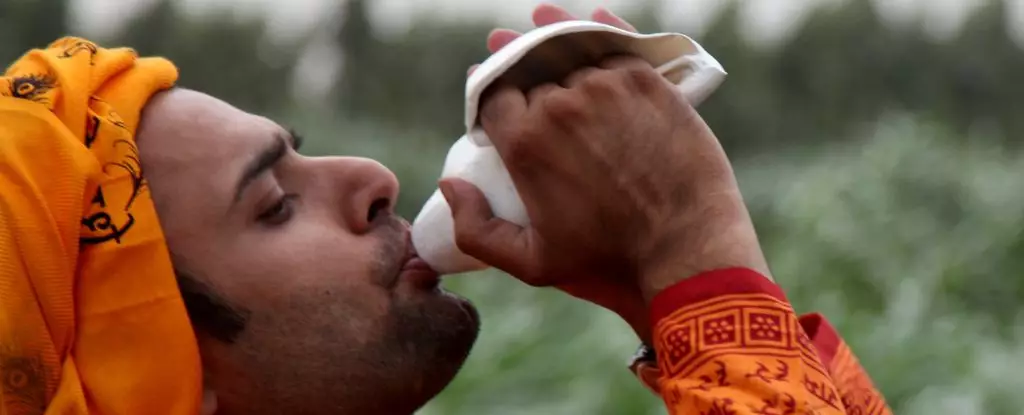In an era where technological advances dominate health interventions, the resurgence of traditional practices as therapeutic tools provides a refreshing perspective. Recent research suggests that engaging in the ancient Indian ritual of shankh (conch shell) blowing could offer a natural, accessible alternative to conventional sleep disorder treatments, especially for those suffering from obstructive sleep apnea (OSA). This approach champions a holistic view—embracing cultural heritage and embodied breathing exercises as pathways to improved health.
The core idea revolves around harnessing vibration, airflow resistance, and muscular engagement through ancient wind practices. Unlike the clinical mechanism of a CPAP machine, which relies on continuous airflow to keep airways open, the shankh exercise emphasizes active participation, fostering muscle strengthening within the upper airway. The practice involves deep inhalations and forceful exhalations through pursed lips, creating vibrations that may fortify the soft tissues vulnerable to collapse during sleep. This method resonates with yogic traditions, integrating breathing control with physical and mental well-being.
What makes this approach truly compelling is its accessibility and cultural resonance. Not everyone adapts well to mechanical aids or invasive treatments, often citing discomfort and inconsistent compliance. The shankh technique, rooted in centuries-old rituals, requires minimal equipment—just a conch shell—and can be performed in a calm, familiar environment. Its simplicity masks a potent potential for systemic benefits, especially in light of small but promising clinical trials demonstrating significant improvements.
Scientific Insights with Cultural Roots
The recent randomized controlled trial involving a modest group of individuals with moderate OSA illuminates the potential for traditional wind practices to improve sleep quality. Participants practicing conch blowing reported not only feeling more rested upon waking but also showed measurable improvements—fewer apneas and higher blood oxygen saturation during sleep. These physiological changes indicate a strengthening of upper airway muscles, possibly reducing the likelihood of airway collapse—a hallmark of OSA.
Interestingly, the practice is more than just a lung exercise; it encompasses vibrations that might induce neuromuscular adaptations. By repeatedly engaging the soft palate, throat, and surrounding muscles, it could help in creating a more stable airway structure. Moreover, the rhythmic nature of the technique promotes relaxation and mindfulness, addressing the often-overlooked mental dimensions of sleep quality.
It’s essential to recognize the limitations of the study—the small sample size and lack of blinding mean results should be interpreted with cautious optimism. Nonetheless, the implications are profound. If further research validates these initial findings, we might have a culturally integrated, low-cost alternative or complement to conventional treatments. Such a paradigm shift could revolutionize how we approach sleep health, especially in regions where traditional practices are deeply ingrained.
Challenging the Dominance of Modern Medical Modalities
The potential of traditional wind-based exercises challenges the dominance of high-tech sleep interventions like CPAP, which, despite its efficacy, remains burdensome for many users. The discomfort, noise, and inconvenience often hinder consistent compliance, diminishing its long-term effectiveness. The notion that an ancient, accessible ritual could serve as a practical supplement or even substitute invites a critical reevaluation of our reliance on complex machinery.
Beyond OSA, this approach taps into a broader philosophy of mind-body harmony. Breathing exercises, particularly those involving vibratory patterns, have long been associated with stress reduction, emotional regulation, and enhanced respiratory function. Integrating such practices into clinical treatment plans could foster a more holistic, patient-centered approach that respects cultural traditions while embracing scientific validation.
Moving forward, larger, more rigorous studies are essential to establish efficacy and determine optimal protocols. If successful, healthcare systems might incorporate these practices, offering patients a range of options aligned with their preferences and cultural backgrounds. Such an inclusive approach not only broadens treatment paradigms but also empowers individuals to participate actively in their health journeys.
In the end, bridging ancient wisdom with modern science holds the promise of more compassionate, effective, and sustainable health solutions. The humble conch shell, a symbol of spiritual and cultural significance across civilizations, might soon find its place as a tool for awakening better sleep, vitality, and overall well-being.


Leave a Reply